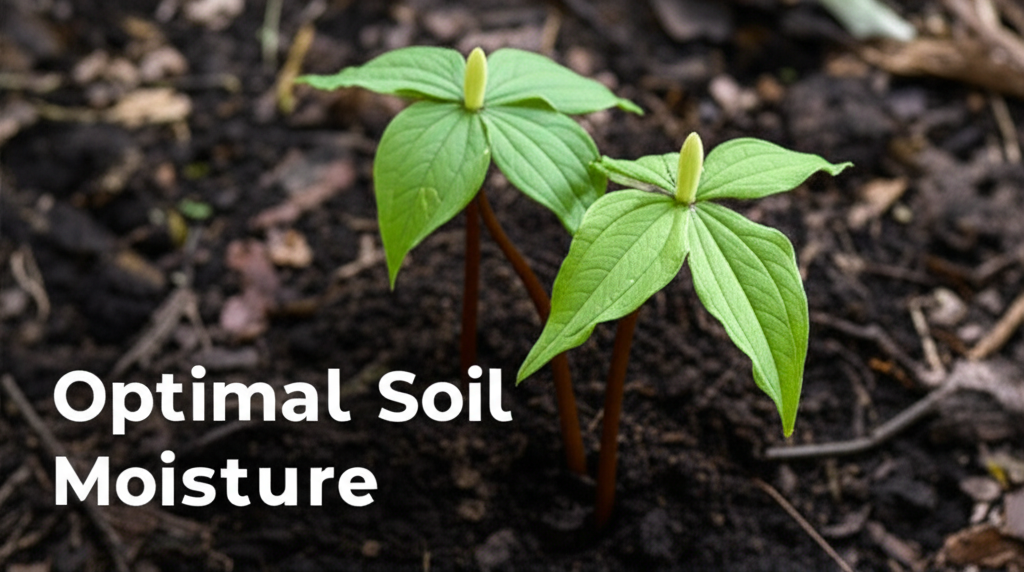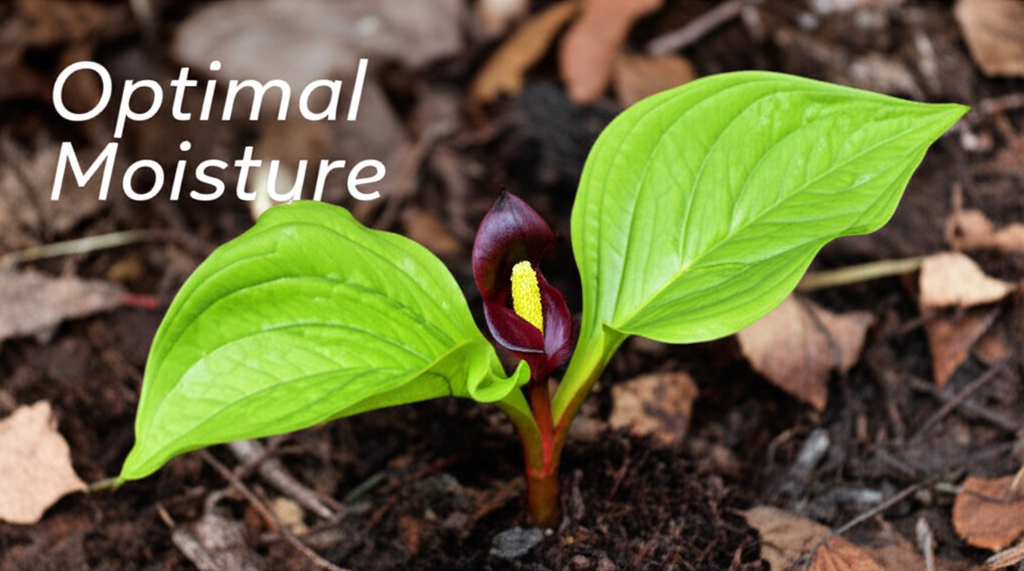Unveiling the Mystique of the Jack-in-the-Pulpit
The Jack-in-the-Pulpit (Arisaema triphyllum) is a captivating native wildflower that graces the dappled shade of North American woodlands. Its unique, hooded spathe enclosing a spadix, resembling a preacher at a pulpit, has earned it a place of fascination in the hearts of gardeners and nature enthusiasts alike. Beyond its aesthetic appeal and intriguing form, understanding the specific needs of this woodland gem, particularly its soil moisture requirements, is paramount to its successful cultivation. This comprehensive guide delves deep into the ideal soil moisture conditions for Jack-in-the-Pulpit, offering actionable strategies for optimization and ensuring your plants flourish.
Understanding Jack-in-the-Pulpit’s Natural Habitat

To truly optimize soil moisture for Jack-in-the-Pulpit, we must first understand its native environment. These plants thrive in deciduous forests, where they typically grow in:
- Moist, but not waterlogged, soils.
- Rich, organic matter-laden soil.
- Areas with a consistent canopy cover that filters sunlight and retains humidity.
- Locations that experience distinct wet and dry periods throughout the year, mimicking natural seasonal cycles.
This natural inclination tells us that while Jack-in-the-Pulpit appreciates consistent moisture, it’s not a bog plant. It requires a delicate balance, avoiding both drought stress and the suffocating conditions of perpetually saturated ground.
The Crucial Role of Soil Moisture for Jack-in-the-Pulpit
Soil moisture is not merely about watering; it’s a complex interplay that influences nutrient uptake, root health, disease resistance, and overall plant vigor. For Jack-in-the-Pulpit, correct moisture levels are critical for:
- Nutrient Absorption: Water acts as a solvent, dissolving essential nutrients in the soil and making them available for plant uptake through their root systems. Inadequate moisture can hinder this process, leading to nutrient deficiencies.
- Root System Development: A consistently moist soil encourages a robust and deep root system. Conversely, prolonged dryness can cause roots to become shallow and stressed, making the plant more vulnerable to drought.
- Preventing Desiccation: The delicate tissues of the Jack-in-the-Pulpit, especially its emerging leaves and flower spathe, are susceptible to drying out. Adequate moisture helps maintain turgor pressure, preventing wilting and damage.
- Fungal Disease Prevention: While Jack-in-the-Pulpit needs moisture, it’s crucial to avoid conditions that promote fungal pathogens. Overly wet, poorly draining soil creates a breeding ground for root rot and other diseases.
- Supporting the Dormancy Period: After the plant dies back in late summer or fall, the corm (underground storage organ) still requires some moisture to remain viable.
Identifying Optimal Soil Moisture Levels
Determining the “perfect” moisture level can seem elusive, but it’s achievable with observation and understanding. For Jack-in-the-Pulpit, the ideal state is often described as:
- Consistently moist, like a wrung-out sponge.
- Not soggy or waterlogged.
- Allowing for slight drying between waterings, particularly during drier spells.
A simple and effective way to gauge this is the “finger test.” Insert your finger about two inches into the soil.
- If the soil feels dry at that depth, it’s time to water.
- If it feels moist but not muddy, the moisture level is likely good.
- If it feels saturated and muddy, you may have an issue with drainage.
The Importance of Soil Type
The type of soil you have significantly impacts how it retains moisture. Jack-in-the-Pulpit prefers well-draining, humus-rich soil.
- Sandy soils drain quickly and may require more frequent watering.
- Clay soils retain moisture but can become waterlogged if not amended.
- Loamy soils, a combination of sand, silt, and clay, generally offer the best balance of drainage and moisture retention.
Amending your soil with organic matter is a cornerstone of moisture optimization, regardless of your native soil type.
Key Factors Influencing Soil Moisture Needs
Several external factors will dictate how often and how much you need to water your Jack-in-the-Pulpit:
| Factor | Impact on Moisture Needs | Considerations |
|---|---|---|
| Climate/Temperature | Higher temperatures increase evaporation, leading to faster soil drying. | Water more frequently during hot, dry spells. Reduce watering in cooler periods. |
| Sunlight Exposure | Full sun dries soil much faster than dappled shade. | Jack-in-the-Pulpits prefer shade or partial shade; minimize exposure to direct sun. |
| Rainfall | Natural rainfall can supplement or eliminate the need for supplemental watering. | Monitor rainfall and adjust your watering schedule accordingly. |
| Soil Composition | The organic content and particle size of the soil affect water retention. | Amend soil to improve drainage or moisture retention as needed. |
| Plant Age/Size | Younger plants with less established root systems are more susceptible to drought. | Provide consistent moisture for seedlings and newly planted specimens. |
| Mulch Layer | A good layer of mulch helps retain soil moisture. | Ensure mulch is kept a short distance from the plant’s crown to prevent rot. |
Strategies for Optimizing Soil Moisture
Achieving the ideal moisture balance involves a multi-pronged approach, focusing on soil preparation, watering techniques, and environmental management.
1. Soil Amendment: The Foundation of Moisture Control
Improving your soil’s structure is the most impactful step. Jack-in-the-Pulpit thrives in soil that is rich in organic matter.
- Compost: Well-rotted compost is an excellent soil amendment. It improves drainage in clay soils and increases water retention in sandy soils. It also provides essential nutrients.
- Leaf Mold: Decomposed leaves create a nutrient-rich, moisture-retentive material that mimics woodland conditions perfectly.
- Aged Manure: Ensure manure is fully composted to avoid burning plant roots.
- Peat Moss (use with caution): While peat moss improves moisture retention, its sustainability is a concern. If used, ensure it’s sourced responsibly.
When amending, aim to incorporate at least 2-3 inches of organic matter into the top 6-8 inches of soil before planting.
2. Mulching: Nature’s Moisture Blanket
Mulch is an indispensable tool for maintaining consistent soil moisture. It acts as a barrier, reducing evaporation, suppressing weeds (which compete for water), and regulating soil temperature.
- Organic Mulches: Shredded bark, leaf litter, compost, and pine needles are ideal.
- Application: Apply a layer of 2-3 inches of mulch around the base of the plants, keeping it a few inches away from the stem to prevent rot.
- Replenishment: Organic mulches decompose over time and will need to be replenished annually or bi-annually.
3. Watering Techniques: Watering Wisely
How and when you water are just as important as the amount.
- Deep and Infrequent Watering: Encourage roots to grow deeper by watering thoroughly when the top inch or two of soil feels dry. This is more beneficial than frequent, shallow watering.
- Water at the Base: Direct water to the soil around the plant’s base, avoiding wetting the foliage. Wet leaves can promote fungal diseases.
- Morning Watering: Watering in the morning allows any surface moisture to evaporate before nightfall, further reducing disease risk.
- Observe Your Plants: Wilting leaves are a clear sign of thirst. However, also be mindful of overwatering, which can lead to yellowing leaves and root rot.
4. Drainage Considerations: The Art of Avoiding Waterlogging
Good drainage is non-negotiable for Jack-in-the-Pulpit.
- Site Selection: Avoid planting in low-lying areas where water collects.
- Raised Beds: If your natural soil has poor drainage, consider planting in raised beds filled with a suitable soil mix.
- Incorporate Grit: For very heavy clay soils, adding coarse sand or horticultural grit can improve drainage.
Troubleshooting Common Soil Moisture Issues
Even with the best intentions, you might encounter problems. Here’s how to address them:
Drought Stress Symptoms
- Wilting leaves that don’t perk up overnight.
- Yellowing of lower leaves.
- Stunted growth.
- Flower or fruit (berries) drop.
Solution: Water deeply and assess your mulching and soil composition. Consider a more frequent watering schedule during dry periods.
Overwatering Symptoms
- Yellowing leaves, often starting from the bottom.
- Stunted or mushy growth.
- Foul odor from the soil.
- Visible signs of root rot (dark, soft roots).
Solution: Stop watering immediately. Improve drainage by amending the soil with organic matter and grit. Ensure the plant is not in a waterlogged location. If root rot is severe, you may need to dig up the plant, trim away rotted roots, and replant in better-draining soil.
Jack-in-the-Pulpit Soil Moisture: A Comparison
Understanding how your chosen soil amendments and practices compare is vital.
| Soil Condition/Amendment | Moisture Retention | Drainage | Organic Matter Content | Suitability for Jack-in-the-Pulpit |
|---|---|---|---|---|
| Pure Clay Soil | High | Poor | Variable | Poor without amendment |
| Pure Sandy Soil | Low | Excellent | Low | Poor without amendment |
| Unamended Loam | Moderate | Good | Moderate | Fair |
| Loam + Compost (30%) | Good | Good | High | Excellent |
| Amended Clay (with compost & grit) | Good | Good | High | Excellent |
| Amended Sand (with compost) | Good | Good | High | Excellent |
| Constantly Waterlogged Soil | Excessive | None | Variable | Fatal |
| Bone Dry Soil | None | Excessive | Low | Fatal |
The Seasonal Rhythm of Jack-in-the-Pulpit Moisture Needs
Jack-in-the-Pulpit’s moisture requirements shift throughout the year, mirroring the natural cycles of its woodland home.
- Spring: As the plant emerges and grows actively, consistent moisture is crucial. The soil should remain moist, but not saturated, as temperatures begin to warm.
- Summer: During the peak growing season, especially in warmer climates, monitor soil moisture closely. While still needing consistent moisture, allow the very surface to dry slightly between waterings. If the plant begins to yellow or droop, it’s a sign it needs more water.
- Late Summer/Early Fall: As the plant naturally dies back, its moisture needs decrease significantly. The foliage will yellow and wither, signaling the plant is preparing for dormancy. Continue to provide light moisture, ensuring the corm doesn’t completely dry out, but avoid overwatering.
- Winter: During dormancy, the corm needs to remain slightly moist to survive. Natural winter precipitation in most regions is usually sufficient. If you experience prolonged dry spells during winter in a region with limited natural moisture, a very light watering might be considered, but this is rarely necessary in its native range.
Pros and Cons of Different Soil Moisture Management Strategies
Here’s a look at the advantages and disadvantages of various approaches:
| Strategy | Pros | Cons |
|---|---|---|
| Heavy Mulching | Excellent moisture retention, weed suppression, temperature regulation, soil health improvement. | Can mask overwatering if not careful; needs periodic replenishment. |
| Deep, Infrequent Watering | Encourages deep root growth, reduces risk of fungal diseases by allowing soil to breathe. | Requires careful monitoring of soil moisture to avoid drought stress. |
| Frequent, Shallow Watering | Keeps surface soil moist, can be perceived as “safer” by novice gardeners. | Promotes shallow root systems, increases risk of fungal diseases, can lead to salt buildup. |
| Soil Amendment with Organic Matter | Improves both drainage and water retention, provides nutrients, enhances soil structure. | Requires initial effort and ongoing replenishment of organic material. |
| Planting in Waterlogged Areas | N/A | Leads to root rot and plant death; avoid at all costs. |
| Allowing Soil to Dry Out Completely | N/A | Causes severe drought stress, wilting, and potential plant death. |
Conclusion: Cultivating a Thriving Jack-in-the-Pulpit
The Jack-in-the-Pulpit, with its unique charm, rewards attentive gardeners with its graceful presence. By understanding and meticulously optimizing its soil moisture needs, you unlock the key to its success. Remember, it’s about balance: consistently moist, well-draining soil enriched with organic matter, protected by a good layer of mulch, and watered deeply when needed. By observing your plants, understanding your local conditions, and employing the strategies outlined in this guide, you can ensure your woodland garden is a haven for this remarkable native wildflower, allowing its mystique to truly flourish for years to come.


